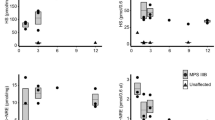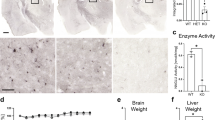Abstract
Neurological dysfunction is common in humans and animals with lysosomal storage diseases. β-Mannosidosis, an autosomal recessive inherited disorder of glycoprotein catabolism caused by deficiency of the lysosomal enzyme β-mannosidase, is characterized by intracellular accumulation of small oligosaccharides in selected cell types. In ruminants, clinical manifestation is severe, and neuropathology includes extensive intracellular vacuolation and dysmyelination. In human cases of β-mannosidosis, the clinical symptoms, including intellectual disability, are variable and can be relatively mild. A β-mannosidosis knockout mouse was previously characterized and showed normal growth, appearance, and lifespan. Neuropathology between 1 and 9 months of age included selective, variable neuronal vacuolation with no hypomyelination. This study characterized distribution of brain pathology in older mutant mice, investigating the effects of two strain backgrounds. Morphological analysis indicated a severe consistent pattern of neuronal vacuolation and disintegrative degeneration in all five 129X1/SvJ mice. However, the mice with a mixed genetic background showed substantial variability in the severity of pathology. In the severely affected animals, neuronal vacuolation was prominent in specific layers of piriform area, retrosplenial area, anterior cingulate area, selected regions of isocortex, and in hippocampus CA3. Silver degeneration reaction product was prominent in regions including specific cortical layers and cerebellar molecular layer. The very consistent pattern of neuropathology suggests metabolic differences among neuronal populations that are not yet understood and will serve as a basis for future comparison with human neuropathological analysis. The variation in severity of pathology in different mouse strains implicates genetic modifiers in the variable phenotypic expression in humans.
Competing interests: None declared
Access this chapter
Tax calculation will be finalised at checkout
Purchases are for personal use only
Similar content being viewed by others
References
Abbitt B, Jones MZ, Kasari TR et al (1991) Beta-mannosidosis in twelve Salers calves. J Am Vet Med Assoc 198:109–113
Alkhayat AH, Kraemer SA, Leipprandt JR, Macek M, Kleijer WJ, Friderici KH (1998) Human beta-mannosidase cDNA characterization and first identification of a mutation associated with human beta-mannosidosis. Hum Mol Genet 7:75–83
Aronson NN Jr, Kuranda MJ (1989) Lysosomal degradation of Asn-linked glycoproteins. FASEB J 3:2615–2622
Auclair D, Hopwood JJ (2007) Morphopathological features in tissues of alpha-mannosidosis guinea pigs at different gestational ages. Neuropathol Appl Neurobiol 33:572–85
Balducci C, Bibi L, Berg T et al (2008) Molecular cloning and structural organization of the gene encoding the mouse lysosomal di-N-acetylchitobiase (ctbs). Gene 416:85–91
Barbaric I, Miller G, Dear TN (2007) Appearances can be deceiving: phenotypes of knockout mice. Brief Funct Genomic Proteomic 6:91–103
Bedilu R, Nummy KA, Cooper A et al (2002) Variable clinical presentation of lysosomal beta-mannosidosis in patients with null mutations. Mol Genet Metab 77:282–290
Blanz J, Stroobants S, Lüllmann-Rauch R et al (2008) Reversal of peripheral and central nervous storage and ataxia after recombinant enzyme replacement therapy in alpha-mannosidosis mice. Hum Mol Genet 17:3437–3445
Boyer PJ, Jones MZ, Rathke EJS, Truscott NK, Lovell KL (1990) Regional central nervous system oligosaccharide storage in caprine beta-mannosidosis. J Neurochem 55:660–664
Bryan L, Schmutz S, Hodges SD, Snyder FF (1993) Bovine beta-mannosidosis: pathologic and genetic findings in Salers calves. Vet Pathol 30:130–139
Cooper A, Sardharwalla IB, Roberts MM (1986) Human beta-mannosidase deficiency. N Engl J Med 315:1231
Cooper A, Hatton CE, Thornley M, Sardharwalla IB (1990) Alpha- and beta-mannosidoses. J Inherit Metab Dis 13:538–548
Crawley AC, Walkley SU (2007) Developmental analysis of CNS pathology in the lysosomal storage disease alpha-mannosidosis. J Neuropathol Exp Neurol 66:687–697
Damme M, Stroobants S, Walkley SU et al (2011) Cerebellar alterations and gait defects as therapeutic outcome measures for enzyme replacement therapy in alpha-mannosidosis. J Neuropathol Exp Neurol 70:83–94
Dunder U, Valtonen P, Kelo E, Mononen I (2010) Early initiation of enzyme replacement therapy improves metabolic correction in the brain tissue of aspartylglycosaminuria mice. J Inherit Metab Dis 33:611–617
Fanselow MS, Dong H-W (2010) Are the dorsal and ventral hippocampus functionally distinct structures? Neuron 65:7. doi:10.1016/j.neuron.2009.11.031
Fix AS, Ross JF, Stitzel SR, Switzer RC (1996) Integrated evaluation of central nervous system lesions: stains for neurons, astrocytes, and microglia reveal the spatial and temporal features of MK-801-induced neuronal necrosis in the rat cerebral cortex. Toxicol Pathol 24:291–304
Jalanko A, Tenhunen K, McKinney CE et al (1998) Mice with an aspartylglucosaminuria mutation similar to humans replicate the pathophysiology in patients. Human Molec Genet 7:265–272
Jones MZ, Dawson G (1981) Caprine beta-mannosidosis: inherited deficiency of beta-D-mannosidase. J Biol Chem 256:5185–5188
Jones MZ, Laine RA (1981) Caprine oligosaccharide storage disease accumulation of beta-mannosyl (1–4) beta-N-acetylglucosaminyl (1–4) beta-N-acetylglucosamine in brain. J Biol Chem 256:5181–5184
Jones MZ, Cunningham JG, Dade AW et al (1983) Caprine beta-mannosidosis: clinical and pathological features. J Neuropathol Exp Neurol 42:268–285
Kaartinen V, Mononen I, Voncken JW (1996) A mouse model for the human lysosomal disease aspartylglycosaminuria. Nat Med 2:1375–1378
Lein ES, Hawrylycz MJ, Ao N et al (2007) Genome-wide atlas of gene expression in the adult mouse brain. Nature 445:168–176
Lieberman AP, Puertollano R, Raben N, Slaugenhaupt S, Walkley SU, Ballabio A (2012) Autophagy in lysosomal storage disorders. Autophagy 8:719–730
Lovell KL, Jones MZ (1983) Distribution of central nervous system lesions in beta-mannosidosis. Acta Neuropathol 62:121–126
Lovell KL, Jones MZ (1985) Axonal and myelin lesions in beta-mannosidosis: ultrastructural characteristics. Acta Neuropathol 65:293–299
Lovell KL, Kranich RJ, Cavanagh KT (1994) Biochemical and histochemical analysis of lysosomal enzyme activities in caprine beta-mannosidosis. Molec Chem Neuropath 21:61–74
Matsuura F, Jones MZ (1985) Structural characterization of novel complex oligosaccharides accumulated in the caprine beta-mannosidosis kidney: Occurrence of tetra- and pentasaccharides containing a beta-linked mannose residue at the nonreducing terminus. J Biol Chem 260:15239–1524
Neufeld EF (1991) Lysosomal storage diseases. Annu Rev Biochem 60:257–280
Ong WY, Kumar U, Switzer RC et al (2001) Neurodegeneration in Niemann-Pick type C disease mice. Exp Brain Res 141:218–231
Patterson JS, Jones MZ, Lovell KL, Abbitt B (1991) Neuropathology of bovine beta-mannosidosis. J Neuropathol Exp Neurol 50:538–546
Sanford LP, Kallapur S, Ormsby M, Doetschman T (2001) Influence of genetic background on knockout mouse phenotypes. Gene Knockout Protocols, Methods in Molec Biol 158:217–225
Stinchi S, Lullmann-Rauch R, Hartmann D et al (1999) Targeted disruption of the lysosomal alpha-mannosidase gene results in mice resembling a mild form of human alpha-mannosidosis. Hum Mol Genet 8:1365–1372
Suzuki K, Ezoe T, Tohyama J, Matsuda J, Vanier MT, Suzuki K (2003) Are animal models useful for understanding the pathophysiology of lysosomal storage disease? Acta Paediatr Suppl 92:54–62
Thompson CL, Pathak SD, Jeromin A et al (2008) Genomic anatomy of the hippocampus. Neuron 60:1010–1021
vanPelt J, Hokke CH, Dorland L, Duran M, Kamerling JP, Vliegenthart JF (1990) Accumulation of mannosyl-beta(1–4)-N-acetylglucosamine in fibroblasts and leukocytes of patients with a deficiency of beta-mannosidase. Clin Chim Acta 187:55–60
Vite CH, McGowen JC, Braund KG et al (2001) Histopathology, electrodiagnostic testing, and magnetic resonance imaging show significant peripheral and central nervous system myelin abnormalities in the cat model of alpha-mannosidosis. J Neuropath Exp Neurol 60:817–828
Walkley SU (2009) Pathogenic cascades in lysosomal disease – Why so complex? J Inher Met Dis 32:181–189
Wenger DA, Sujansky E, Fennessey PV, Thompson JN (1986) Human beta-mannosidase deficiency. N Engl J Med 315:1201–1205
Winchester B (2005) Lysosomal metabolism of glycoproteins. Glycobiology 15:1R–15R
Winchester B, Vellodi A, Young E (2000) The molecular basis of lysosomal storage diseases and their treatment. Biochem Soc Trans 28:150–154
Zhu M, Lovell KL, Patterson JS, Saunders TL, Hughes ED, Friderici KH (2006) Beta-mannosidosis mice: a model for the human lysosomal storage disease. Human Molec Genetics 15:493–500
Acknowledgments
Processing and staining of mouse brains was generously provided by NeuroScience Associates. This work was supported by NIDDK grant DK49782 from the National Institutes of Health to KHF, and by Michigan State University Foundation grant to KHF and KLL.
Author information
Authors and Affiliations
Corresponding author
Editor information
Editors and Affiliations
Additional information
Communicated by: Ashok Vellodi
Appendices
Synopsis
In β-mannosidosis, the neuronal pathology observed in mice is consistent with the intellectual disability displayed in human cases, and the variation among different strains implicates genetic modifiers in variable phenotypic expression.
Author Who Serves as Guarantor
Kathryn L. Lovell, Ph.D.
Details of Funding
Processing and staining of mouse brains was generously provided by NeuroScience Associates. This work was supported by NIDDK grant DK49782 from the National Institutes of Health to KF, and by Michigan State University Foundation grant to KF and KL.
Compliance with Ethics Guidelines
Conflict of Interest
Kathryn Lovell, Mei Zhu, Meghan Drummond, Robert Switzer, and Karen Friderici declare that they have no conflict of interest. The authors confirm independence from the sponsors; the content of the article has not been influenced by the sponsors.
Informed Consent
Informed consent: not required. This article does not contain any studies with human subjects performed by any of the authors.
Use of Vertebrate Animals
All institutional and national guidelines for the care and use of laboratory animals were followed.
Details of the Contributions of Individual Authors
- KLL::
-
designed the study, participated in perfusion and brain removal, analyzed results to generate distribution of pathology, took a lead role in writing the manuscript.
- MZ::
-
produced the mutant mice, bred them for the current experiments, responsible for perfusion and brain removal, participated in writing the manuscript.
- MCD::
-
assisted with breeding mice, assisted with analysis of data, participated in writing the manuscript.
- RCS::
-
processed the brains for sectioning and staining, participated in photography and analysis of results, participated in writing the manuscript.
- KHF::
-
supervised production of the mutant mice and breeding, participated in writing the manuscript.
Rights and permissions
Copyright information
© 2013 SSIEM and Springer-Verlag Berlin Heidelberg
About this chapter
Cite this chapter
Lovell, K.L., Zhu, M., Drummond, M.C., Switzer, R.C., Friderici, K.H. (2013). Distribution and Severity of Neuropathology in β-Mannosidase-Deficient Mice is Strain Dependent. In: Zschocke, J., Gibson, K., Brown, G., Morava, E., Peters, V. (eds) JIMD Reports - Case and Research Reports, Volume 13. JIMD Reports, vol 13. Springer, Berlin, Heidelberg. https://doi.org/10.1007/8904_2013_258
Download citation
DOI: https://doi.org/10.1007/8904_2013_258
Received:
Revised:
Accepted:
Published:
Publisher Name: Springer, Berlin, Heidelberg
Print ISBN: 978-3-642-54148-3
Online ISBN: 978-3-642-54149-0
eBook Packages: MedicineMedicine (R0)




